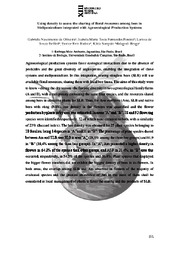Using density to assess the sharing of floral resources among bees in meliponiculture integrated with agroecological production systems.
Using density to assess the sharing of floral resources among bees in meliponiculture integrated with agroecological production systems.
Author(s): OLIVEIRA, G. N. de; PEREIRA, I. M. T. F.; BELLINI, L. de S.; BATISTA, E. R.; MALAGODI-BRAGA, K. S.
Summary: Agroecological production systems favor ecological interactions due to the absence of pesticides and the great diversity of angiosperms, enabling the integration of these systems and meliponiculture. In this integration, rearing stingless bees (SLB) will use available floral resources, sharing them with local bee fauna. The aims of this study were to know – during the dry season - the floristic diversity in two agroecological family farms (A and B), with a meliponary containing the same four species, and the resources shared among bees in attractive plants for SLB. Thus, for Apis mellifera (Am), SLB and native bees with sting (NBS), bee density in the flowers was quantified and the flower production by plants or by area was estimated. In areas “A” and “B”, 78 and 92 flowering species were identified respectively, 32 of which were common to both, with a similarity of 23% (Jaccard index). The bee density was obtained for 25 plant species belonging to 20 families, being 14 species in “A” and 11 in “B”. The percentage of plant species shared between Am and SLB was 50,0 in area “A” (28,6% among the three bee groups) and 81,9 in “B” (36,4% among the three bee groups). In “A”, Am presented a higher density in flowers in 64.3% of the species than other groups, and ASF in 21.4%; in “B” area this occurred, respectively, in 54.5% of the species and 36.4%. Plant species that displayed the bigger flower numbers did not exhibit the biggest density of bees in its flowers. In both areas, the overlap among SLB and Am observed in flowers of the majority of evaluated species and the greatest abundance of Am in the most of them shall be considered in local management of plants to favor the rearing and the products of SLB.
Publication year: 2024
Types of publication: Abstract in annals or event proceedings
Unit: Embrapa Environment
Keywords: Agroecology, Floral resources, Meliponiculture
Observation
Some of Embrapa's publications are published as ePub files. To read them, use or download one of the following free software options to your computer or mobile device. Android: Google Play Books; IOS: iBooks; Windows and Linux: Calibre.
Access other publications
Access the Agricultural Research Database (BDPA) to consult Embrapa's full library collection and records.
Visit Embrapa Bookstore to purchase books and other publications sold by Embrapa.

